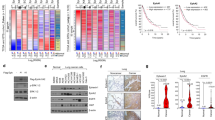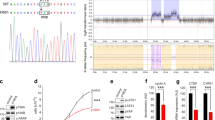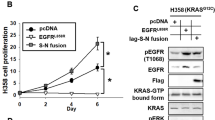Abstract
Non-small cell lung cancers (NSCLC) that express the cell surface adhesion protein E-cadherin may carry a better prognosis than E-cadherin-negative tumors. Here, we found substantial inhibition of anchorage-independent growth in soft agar and cell migration in each of four NSCLC lines stably transfected with E-cadherin. The inhibitory effects were independent of the EGFR and β-catenin/Wnt-signaling pathways. However, E-cadherin expression was associated with an adhesion-dependent reduction in the activity of Rho family proteins, RhoA in two lines and Cdc42 in the other two. The reduction of RhoA activity was dependent on DLC-1 Rho-GAP and p190 Rho-GAP and associated with an increase in a membrane-associated p190 Rho-GAP/p120 Ras-GAP complex. In parental cells with high levels of RhoA-GTP, siRNA-mediated knock-down of RhoA reduced cell migration and agar growth in a manner analogous to E-cadherin. In parental cells with high levels of Cdc42-GTP, transfection of a Cdc42 dominant-negative mutant reduced cell growth and migration similarly to cells expressing E-cadherin. Thus, E-cadherin can negatively regulate cell proliferation and migration in NSCLC by reducing the level of the predominant active form of Rho family protein, RhoA or Cdc42. These proteins can be considered downstream effectors of E-cadherin and might represent therapeutic targets in some NSCLC.
This is a preview of subscription content, access via your institution
Access options
Subscribe to this journal
Receive 50 print issues and online access
$259.00 per year
only $5.18 per issue
Buy this article
- Purchase on Springer Link
- Instant access to full article PDF
Prices may be subject to local taxes which are calculated during checkout








Similar content being viewed by others
References
Aktories K, Wilde C, Vogelsgesang M . (2004). Rho-modifying C3-like ADP-ribosyltransferases. Rev Physiol Biochem Pharmacol 152: 1–22.
Beherens J, von Kries JP, Kühl M, Bruhn L, Wedlich D, Grosschedl R et al. (1996). Functional interaction of beta-catenin with the transcription factor LEF-1. Nature 382: 638–642.
Boerner JL, Biscardi JS, Silva CM, Parsons SJ . (2005). Transactivating agonists of the EGF receptor require Tyr 845 phosphorylation for induction of DNA synthesis. Mol Carcinog 44: 262–273.
Bohm M, Totzeck B, Birchmeier W, Wieland I . (1994). Differences of E-cadherin expression levels and patterns in primary and metastatic human lung cancer. Clin Exp Metastasis 12: 55–62.
Bourne HR, Sanders DA, McCormick F . (1991). The GTPases superfamily: conserved structure and molecular mechanism. Nature 349: 117–127.
Brembeck F, Rosario M, Birchmeier W . (2006). Balancing cell adhesion and Wnt signaling, the key role of beta-catenin. Curr Opin Genetics Dev 16: 51–59.
Bremm A, Walch A, Fuchs M, Mages J, Duyster J, Keller G et al. (2008). Enhanced activation of epidermal growth factor receptor caused by tumor-derived E-cadherin mutations. Cancer Res 68: 707–714.
Bremnes RM, Veve R, Gabrielson E, Hirsch FR, Baron A, Bemis L et al. (2002a). High-throughput tissue microarray analysis used to evaluate biology and prognostic significance of the E-cadherin pathway in non-small-cell lung cancer. J Clin Oncol 20: 2417–2428.
Bremnes RM, Veve R, Hirsch FR, Franklin WA . (2002b). The E-cadherin cell-cell adhesion complex and lung cancer invasion, metastasis, and prognosis. Lung Cancer 36: 115–124.
Capuzzo F, Hirsch FR, Rossi E, Bartolini S, Ceresoli GL, Bemis L et al. (2005). Epidermal growth factor receptor gene and protein and gefitinib sensitivity in Non-small cell lung cancer. J Natl Cancer Inst 97: 743–655.
Chong IW, Chang MY, Sheu CC, Wang CY, Hwang JJ, Huang MS et al. (2007). Detection of activated K-ras in non-small cell lung cancer by membrane array: a comparison with direct sequencing. Oncol Report 18: 17–24.
Deeb G, Wang J, Ramnath N, Slocum H, Wiseman S, Beck A et al. (2004). Altered E-cadherin and epidermal growth factor receptor expressions are associated with patient survival in lung cancer: a study utilizing high-density tissue microarray and immunohistochemistry. Modern Pathol 17: 430–439.
Durkin ME, Yuan BZ, Zhou X, Zimonjic DB, Lowy DR, Thorgeirsson SS et al. (2007). DLC-1 a Rho GTPase-activating protein and tumour suppressor. J Cell Mol Med 11: 1185–11207.
Fei Q, Zhang H, Chen X, Wang JC, Zhang R, Xu W et al. (2002). Defected expression of E-cadherin in non-small cell lung cancer. Lung Cancer 37: 147–152.
Fodde R, Brabletz T . (2007). Wnt/beta-catenin signaling in cancer stemness and malignant behavior. Curr Opin Cell Biol 19: 150–158.
Fromm C, Coso OA, Montaner S, Xu N, Gutkind JS . (1997). The small GTP-binding protein Rho links G protein-coupled receptors and Galpha12 to the serum response element and to cellular transformation. Proc Natl Acad Sci USA 94: 10098–10103.
Fukata M, Nakagawa M, Kuroda S, Kaibuchi K . (1999). Cell adhesion and Rho small GTPases. J Cell Science 112: 4491–4500.
Fukata M, Nakagawa M, Kaibuchi K . (2003). Roles of Rho-family GTPases in cell polarisation and directional migration. Curr Opin Cell Biol 15: 590–597.
Gottardi CJ, Wong E, Gumbiner BM . (2001). E-cadherin suppresses cellular transformation by inhibiting beta-catenin signaling in an adhesion-independent manner. J Cell Biol 153: 1049–1060.
Gottardi CJ, Gumbiner BM . (2004). Distinct molecular forms of beta-catenin are targeted to adhesive or transcriptional complexes. J Cell Biol 167: 339–349.
Grewal T, Enrich C . (2006). Molecular mechanisms involved in Ras inactivation: the annexin A6-p120GAP complex. Bioessays 28: 1211–1220.
Gumbiner BM . (1996). Cell adhesion: the molecular basis of tissue architecture and morphogenesis. Cell 84: 345–357.
Hajra KM, Chen DY, Fearon ER . (2002). The SLUG zinc-finger protein represses E-cadherin in breast cancer. Cancer Res 62: 1613–1618.
Heijink IH, Kies PM, Kauffman HF, Postma DS, van Oosterhout AJ, Vellenga E . (2007). Down-regulation of E-cadherin in human bronchial epithelial cells leads to epidermal growth factor receptor-dependent Th2 cell-promoting activity. J Immunol 178: 7678–7685.
Hill CS, Wynne J, Treisman R . (1995). The Rho family GTPases RhoA, Rac1, and CDC42Hs regulate transcriptional activation by SRF. Cell 81: 1159–1170.
Hlubek F, Spaderna S, Schmalhofer O, Jung A, Kirchner T, Brabletz T . (2007). Wnt/FZD signaling and colorecteal cancer morphogenesis. Fron Biosci 12: 458–470.
Hu KQ, Settleman J . (1997). Tandem SH2 binding sites mediate the RasGAP-RhoGAP interaction: a conformational mechanism for SH3 domain regulation. EMBO J 16: 473–483.
Huang C, Liu D, Ishikawa S, Nakashima T, Makashima N, Yokomise H et al. (2008). Wnt1 overexpression promotes tumour progression in non-small cell lung cancer. Eur J Cancer 44: 2680–2688.
Huber O, Korn R, McLaughlin J, Ohsugi M, Herrmann BG, Kemler R . (1996). Nuclear localization of beta-catenin by interaction with transcription factor LEF-1. Mech Dev 59: 3–10.
Jeanes A, Gottardi CJ, Yap AS . (2008). Cadherins and cancer: how does cadherin dysfunction promote tumor progression? Oncogene 27: 6920–6929.
Jemal A, Siegel R, Ward E, Hao Y, Xu J, Murray T et al. (2008). Cancer Statistics, 2008. Cancer J Clin 58: 70–95.
Kim JB, Islam S, Kim YJ, Prudoff RS, Sass KM, Wheelock MJ et al. (2000). N-Cadherin extracellular repeat 4 mediates epithelial to mesenchymal transition and increased motility. J Cell Biol 151: 1193–1206.
Kris M . (2005). How today's developments in the treatment of Non-Small Cell Lung Cancer will change tomorrow's standards of care. Oncologist 10: 23–29.
Laemmli UK . (1970). Cleavage of structural proteins during the assembly of the head of bacteriophage T4. Nature 227: 680–685.
Lee HC, Kim M, Wands JR . (2006). Wnt/Frizzled signaling in hepatocellular carcinoma. Front Biosci 11: 1901–1915.
Lock JG, Hammond LA, Houghton F, Gleeson PA, Stow JL . (2005). E-Cadherin transport from the trans-Golgi network in tubulovesicular carriers is selectively regulated by Golgin-97. Traffic 6: 1142–1156.
Molenaar M, van de Wetering M, Oosterwegel M, Peterson-Maduro J, Godsave S, Korinek V et al. (1996). XTcf-3 transcription factor mediates beta-catenin-induced axis formation in Xenopus embryos. Cell 86: 391–399.
Molina-Ortiz I, Bartolomé RA, Hernández-Varas P, Colo GP, Teixidó J . (2009). Overexpression of E-cadherin on melanoma cells inhibits chemokine-promoted invasion involving p190RhoGAP/p120ctn-dependent inactivation of RhoA. J Biol Chem 284: 15147–15157.
Mosmann T . (1983). Rapid colorimetric assay for cellular growth and survival: application to proliferation and cytotoxicity assays. J Immunol Methods 65: 55–63.
Noren NK, Niessen CM, Gumbiner BM, Burridge K . (2001). Cadherin engagement regulates Rho family GTPases. J Biol Chem 276: 33305–33308.
Noren KN, Arthur WT, Burridge K . (2003). Cadherin engagement inhibits RhoA via p190RhoGAP. J Biol Chem 278: 13615–13618.
Olayioye MA, Beuvink I, Horsch K, Daly JM, Hynes NE . (1999). ErbB receptor-induced activation of stat transcription factors is mediated by Src tyrosine kinases. J Biol Chem 274: 17209–17218.
Pao W, Wang TY, Riely GJ, Miller VA, Pan Q, Ladanyi M et al. (2005). KRAS mutations and primary resistance of lung adenocarcinomas to gefitinib or erlotinib. PLoS Med 2: 57–61.
Peinado H, Ballestar E, Esteller M, Cano A . (2004). Snail mediates E-cadherin repression by the recruitment of the Sin3A/histone deacetylase 1 (HDAC1)/HDAC2 complex. Mol Cell Biol 24: 306–319.
Perrais M, Chen X, Perez-Moreno M, Gumbiner BM . (2007). E-cadherin homophilic ligation inhibits cell growth and epidermal growth factor receptor signaling independently of other cell interactions. Mol Biol Cell 18: 2013–2025.
Pirinen RT, Hirvikoski P, Johansson RT, Hollmén S, Kosma VM . (2001). Reduced expression of alpha-catenin, beta-catenin, and gamma-catenin is associated with high cell proliferative activity and poor differentiation in non-small cell lung cancer. J Clin Pathol 54: 391–395.
Qian X, Karpova T, Sheppard AM, McNally J, Lowy DR . (2004). E-cadherin-mediated adhesion inhibits ligand-dependent activation of diverse receptor tyrosine kinases. EMBO J 23: 1739–1748.
Qian X, Li G, Asmussen HK, Asnaghi L, Vass WC, Braverman R et al. (2007). Oncogenic inhibition by a deleted in liver cancer gene requires cooperation between tensin binding and Rho-specific GTPase-activating protein activities. Proc Natl Acad Sci USA 104: 9012–9017.
Ridley AJ . (2004). Rho proteins and cancer. Breast Cancer Res Treat 84: 13–19.
Riely G, Kris M, Rosenbaum D, Marks J, Li A, Chitale D et al. (2008). Frequency and distinctive spectrum of KRAS mutations in never smokers with lung adenocarcinoma. Clin Cancer Res 14: 5731–5734.
Roof RW, Haskell BD, Dukes BD, Sherman N, Kinter M, Parsons SJ . (1998). Phosphotyrosine (p-Tyr)-dependent and -independent mechanisms of p190 RhoGAP-p120 RasGAP interaction: Tyr 1105 of p190, a substrate for c-Src, is the sole p-Tyr mediator of complex formation. Mol Cell Biol 18: 7052–7063.
Shen Y, Hirsch DS, Sasiela CA, Wu WJ . (2007). Cdc42 regulates E-cadherin ubiquitination and degradation through an epidermal growth factor receptor to Src-mediated pathway. J Biol Chem 283: 5127–5137.
Shih JY, Tsai MF, Chang TH, Chang YL, Yuan A, Yu CJ et al. (2005). Transcription repressor slug promotes carcinoma invasion and predicts outcome of patients with lung adenocarcinoma. Clin Cancer Res 11: 8070–8078.
Sordella R, Bell DW, Haber D, Settleman J . (2004). Gefitinib-sensitizing EGFR mutations in lung cancer activate anti-apoptotic pathways. Science 305: 1163–1167.
Takai Y, Sasaki T, Tanaka K, Nakanishi H . (1995). Rho as a regulator of the cytoskeleton. Trends Biochem Sci 20: 227–231.
Takeichi M . (1995). Morphogenetic roles of classic cadherins. Curr Opin Cell Biol 7: 619–627.
Tang Y, Olufemi L, Wang M, Nie D . (2008). Role of Rho GTPases in breast cancer. Frontiers Biosci 13: 759–776.
Tcherkezian J, Lamarche-Vane N . (2007). Current knowledge of the large RhoGAP family of proteins. Biol Cell 99: 67–86.
Toyoyama H, Nuruki K, Ogawa H, Yanagi M, Matsumoto H, Nishijima H et al. (1999). The reduced expression of e-cadherin, alpha-catenin and gamma-catenin but not beta-catenin in human lung cancer. Oncol Rep 6: 81–85.
Tu SS, Wu WJ, Yang W, Nolbant P, Hahn K, Cerione RA . (2002). Antiapoptotic Cdc42 mutants are potent activators of cellular transformation. Biochemistry 41: 12350–12358.
Uchkado Y, Natsugoe S, Okumura H, Setoyama T, Matsumoto M, Ishigami S et al. (2005). Slug expression in the E-cadherin preserved tumors is related to prognosis in patients with esophageal squamous cell carcinoma. Clin Cancer Res 11: 1174–1180.
van de Wetering M, Barker N, Harkes IC, van der Heyden M, Dijk NJ, Hollestelle A et al. (2001). Mutant E-cadherin breast cancer cells do not display constitutive Wnt signaling. Cancer Res 61: 278–284.
Vincan E, Barker N . (2008). The upstream components of the Wnt signalling pathway in the dynamic EMT and MET associated with colorectal cancer progression. Clin Exp Metastasis 25: 657–663.
Watabe M, Nagafuchi A, Tsukita S, Takeichi M . (1994). Induction of polarized cell-cell association and retardation of growth by activation of the E-cadherin-catenin adhesion system in a dispersed carcinoma line. J Cell Biol 127: 247–256.
Witta S, Gemmill RM, Hirsch FR, Coldren CD, Hedman K, Ravdel L et al. (2006). Restoring E-cadherin expression increases sensitivity to epidermal growth factor receptor inhibitors in lung cancer cell lines. Cancer Res 66: 944–950.
Yoshiura K, Kanai Y, Ochiai A, Shimoyama Y, Sugimura T, Hirohashi S . (1995). Silencing of the E-cadherin invasion-suppressor gene by CpG methylation in human carcinomas. Proc Natl Acad Sci USA 92: 7416–7419.
Acknowledgements
We thank Drs Margaret Wheelock, Wen Jin Wu, Dianne Hirsch and Silvio Gutkind for providing plasmids, Drs Curt Harris and Terry Moody for providing NSCLC cell lines, Dr Cynthia Masison and Mike Radanovich for technical assistance and Dr Giovanna Tosato for helpful discussions. This research has been supported by the Intramural Research Program of the National Institutes of Health, National Cancer Institute, Center for Cancer Research.
Author information
Authors and Affiliations
Corresponding author
Ethics declarations
Competing interests
The authors declare no conflict of interest.
Additional information
Supplementary Information accompanies the paper on the Oncogene website
Rights and permissions
About this article
Cite this article
Asnaghi, L., Vass, W., Quadri, R. et al. E-cadherin negatively regulates neoplastic growth in non-small cell lung cancer: role of Rho GTPases. Oncogene 29, 2760–2771 (2010). https://doi.org/10.1038/onc.2010.39
Received:
Revised:
Accepted:
Published:
Issue Date:
DOI: https://doi.org/10.1038/onc.2010.39
Keywords
This article is cited by
-
Evaluation of quasi-static and dynamic nanomechanical properties of bone-metastatic breast cancer cells using a nanoclay cancer testbed
Scientific Reports (2021)
-
Contrasting activities of estrogen receptor beta isoforms in triple negative breast cancer
Breast Cancer Research and Treatment (2021)
-
p190A RhoGAP induces CDH1 expression and cooperates with E-cadherin to activate LATS kinases and suppress tumor cell growth
Oncogene (2020)
-
Minimal residual disease in prostate cancer patients after primary treatment: theoretical considerations, evidence and possible use in clinical management
Biological Research (2018)
-
Bulk tumour cell migration in lung carcinomas might be more common than epithelial-mesenchymal transition and be differently regulated
BMC Cancer (2018)



